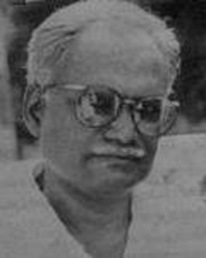கல்லூரியில் ஆங்கில இலக்கியம் படிக்கும் போது சாமுவேல் பெக்கட்டின் வெயிட்டிங் பார் கோதோ வாசித்தேன். அதுவரை நவீன நாடகம் என்பதைப் பற்றி அறிந்திருக்கவில்லை. அந்த நாடகம் வாசிப்பதற்கு மிகுந்த ஆர்வமுடையதாக இருந்தது. அதை எப்படி மேடையேற்றியிருப்பார்கள் என்பதைப் பற்றி எனது பேராசிரியர்களில் ஒரு வரிடம் பேசிக்கொண்டிருந்தபோது அவர் லண்டனில் நடந்த நாடகவிழா ஒன்றில் நிகழ்த்தப்பட்ட கோதோ நாடகத்தின் வீடியோவைக் காண்பதற்குத் தந்தார்.
நான் வாசித்த பிரதிக்கும் நிகழ்த்தபட்ட நாடகத்திற்கும் இடையில் மிகப்பெரிய இடைவெளி
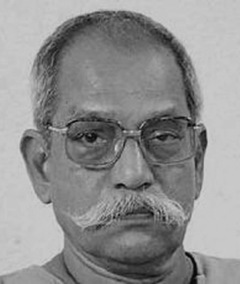
இருந்தது. நிகழ்த்தப்படும் வெளி மற்றும் நடிகர்களின் உடல்மொழி மற்றும் காட்சிகளின் பின்புல இசை யாவும் அந்த நாடகத்தை ஒரு கனவு நிலைப்பட்டதாக மாற்றியிருந்தது. பிரதியை அப்படியே மேடையேற்றுவது அல்ல நாடக இயக்குனரின் வேலை. பிரதியிலிருந்து தனக்கான நாடகமொழியை உருவாக்கிக் கொள்வதுதான் நவீன நாடகத்தின் பிரதான பணி என்று பேராசிரியர் சொன்னபோது எனக்கு அது புரியவில்லை.
அந்நாள்வரை நான் கண்டிருந்த மேடை நாடக வடிவம் முற்றிலும் கலைந்து போய் நடிகர்களின் உடல் மொழியும் நவீன நிகழ்த்து வெளியும் உரையாடும் பாங்கும் தீவிரமாகப் பற்றிக் கொண்டது. என்ன வகை நிகழ்த்துதல் இது. ஏன் தமிழில் இப்படியான நாடகங்கள் நடத்தப்படுவதில்லை. கோதோவை மொழியாக்கம் செய்து இதே போல நிகழ்த்தினால் என்னவென்று அதன் பிந்தைய நாட்களில் தோன்றிக்கொண்டிருந்தது. பத்து நாட்களுக்குள் கோதோவை மொழியாக்கம் செய்துவிட்டேன். ஆனால் அதை எப்படி நிகழ்த்தவது என்பதைப் பற்றி நான் அறிந்திருக்கவில்லை.
நான் அறிந்த இலக்கிய நண்பர்கள் எவரும் அன்று நவீன நாடகம் பற்றி எதையும் அறிந்திருக்கவில்லை. சில மாதங்களுக்கு அதைப் பற்றிப் பேசிக்கொண்டிருந்துவிட்டு பெக் கெட்டை மறந்து வழக்கம் போல நாவல், அபுனைவுக் கட்டுரைகள் என்று வாசிப்பதை நோக்கி நகர ஆரம்பித்தேன். ஆனால் மனதில் பெக்கெட்டின் வரிகள் மற்றும் நிகழ்காட்சிகள் இருந்து கொண்டேயிருந்தது.
அதன் சில ஆண்டுகளுக்கு பின்பு மதுரையில் தற்செயலாக பேராசிரியர் மு.ராமசாமி ஏற்பாடு செய்திருந்த எட்வர்ட் ஆல்பியின் ஜர் ஸ்டோரி என்ற நாடகத்தைப் பார்க்க நேர்ந்தது. என் மனதிலிருந்த பெக்கெட் திரும்பவும் விழித்துக் கொண்டுவிட்டார். அந்த நாட்களில் மதுரையில் சுதேசிகள் என்ற பெயரில் தமிழ்த் துறையில் பயின்ற சுந்தர்காளி ஒரு குழுவை உருவாக்கியிருந்தார். அவர்களுடன் சேர்ந்து நவீன நாடகம் பற்றிப் பேசவும் விவாதிக்கவும் துவங்கினேன்.
விஜய் டெண்டுல்கர், ஹெரால்ட் பைண்டர், ஐயனெஸ்கோ, டென்னஸி வில்லியம்ஸ், லூயி பிராண்டலோ, ஆர்தர் மில்லர், ஒநில், பிரெக்ட், செகாவ், ஜெனே, லோர்க்கா, இப்சன் எட்வர்ட் பாண்ட், வோலே சோயிங்கா என்று நூலகத்தில் கையில் கிடைத்த நாடகப்பிரதிகளை மிகுந்த தீவிரத்தோடு வாசிக்க ஆரம்பித்தேன்.
தமிழில் அப்படி யாருடைய நாடகமாவது இருக்கிறதா என்று தேடியலைந்த போது பழைய ஷேக்ஸ்பியர் பிரதிகள், மற்றும் சங்கரதாஸ் சுவாமிகளின் மரபு நாடகப்பிரதிகள் இருந்தனவேயன்றி நவீன நாடகப்பிரதிகள் எதுவும் காணப்படவில்லை.
அறிந்த நண்பர்களிடம் கேட்டபோது அவர்களும் அப்படி நவீன நாடகப்பிரதி எதுவும் வெளியாகி இருப்பது போல அறியவில்லை என்றார்கள். அந்த நாட்களில்தான் ந. முத்துசாமியின் பெயரைக் கேள்விபட்டேன். நடை இதழில் முத்துசாமியின் காலம் காலமாக வெளி வந்து மிகுந்த கவனத்தைப் பெற்றது என்பதையும் அவரது நாற்காலிக்காரர், சுவரொட்டி நாடகங்களையும் பற்றி நண்பர்கள் விரிவாகச் சொல்லிக்கொண்டிருந்தார்கள்.
நீர்மை எழுதிய முத்துசாமியா நவீன நாடங்கங்கள் போடுகின்றவர் என்று வியப்புடன் கேட்டேன். ஆமாம் அவரேதான் என்றபடியே கூத்துப்பட்டறை என்ற நவீன நாடகக் குழுவைச் சென்னையில் உருவாக்கியிருக்கிறார் என்றும் அது தீவிரமாக நவீன நாடக உருவாக்கத்தில் முனைந்திருக்கிறது என்றும் அறிந்து கொண்டேன்.
எனக்கு முத்துசாமியின் சிறுகதைகளைப் பிடிக்கும். நவீனச் சிறுகதைகளில் அவர் தனித்துவமானவர். குறிப்பாக அவர் கதை சொல்லும் முறை வித்யாசமானது. சிறிய சம்பவங்களை நுட்பமாக விவரித்துக் கொண்டே செல்லும் கதைமுறை அவருடையது. ஊர் சார்ந்த நினைவுகள் மற்றும் நவீன வாழ்வின் அபத்தம் இரண்டும் கலந்த குரல் அவர் கதைகளுக்கு உண்டு. கதாபாத்திரங்களின் நிகழ்வுகளைவிடவும் அவர்களின் மனவோட்டத்திற்கு மிகுந்த முக்கியத்துவம் தரும் எழுத்துமுறை அவருடையது. புஞ்சை என்ற ஊரைப் பற்றிய வெவ்வேறு விதமான பதிவுகள் அவர் கதைகளில் தொடர்ந்து இடம் பெற்றிருந்தன. அத்தோடு கசடதபற இதழ்களில் முத்துசாமி எழுதியதையும் வாசித்திருக்கிறேன்.
நீர்மையின் இன்னொரு சிறப்பு முத்துசாமியின் மகன் ஓவியர் நடேஷ் வரைந்த முகப்பு ஓவியம். மிகச் சிறப்பாக அச்சிடப்பட்டிருந்த புத்தகமது. அதில் முத்துசாமியின் சித்திரம் ஒன்றை மிக நவீனமான முறையில் நடேஷ் வரைந்திருப்பார். அதிலிருந்து ஒரு முத்துசாமியை நாம் கற்பனை செய்து கொள்வது விசித்திரமாக இருக்கும்.
இருபதிற்கும் குறைவான சிறுகதைகளே முத்துசாமி எழுதியிருக்கக்கூடும். ஆனால் அந்தக் கதைகள் அவருக்கெனத் தனியான வாசக உலகை உருவாக்கியிருந்தன. தொடர்ந்து அவர் சிறுகதையுலகில் செயல்படாமல் போனது பெரிய இழப்பே.
நவீன நாடங்களில் ஏற்பட்ட ஈடுபாட்டின் காரணமாக கேரளாவில் உள்ள திருச்சூரில் உள்ள நாடகப்பள்ளிக்கு ஒருமுறை சென்றிருந்தேன். அங்கே நாடகவிழா ஒருவார காலம் நடைபெற்றது. அப்போதுதான் நான் வாசித்திருந்த பல நவீன நாடகங்களை ஒரு சேரக்காணக் கிடைத்தது. நாடகப்பள்ளியின் வளாகமும் அதன் கட்டிட அமைப்பும் மிக நவீனமானவை. அதை லேரி பேக்கர் வடிவமைத்திருந்தார்.
நாடகப்பள்ளியில் நடத்தபட்ட நாடங்களைக் காண்பதற்கு அருகாமையில் உள்ள கிராம மக்கள் வருவதைக் கண்டது ஆச்சரியமாக இருந்தது. லோர்க்காவின் நாடகம் ஒன்றை மலையாளத்தில் நிகழ்த்தினார்கள். சமஸ்கிருத நாடகம் ஒன்று நிகழ்த்தப்பட்டது. அயென்ஸ்கோ நாடகத்தை மாணவர்கள் நிகழ்த்தினார்கள். இப்படி ஒரு வார காலம் நடைபெற்றது. அங்குள்ள மாணவர் விடுதியில் தங்கியபடி நாடகங்களைப் பார்த்து பிரமித்துப் போயிருந்தேன்.
இந்த நாடகங்கள் மேடை அமைப்பை விட்டுவிலகி புதிய நாடகவெளியை உருவாக்கியிருந்ததும் சம்பிரதாயமாக வசனங்களைப் பெரிதும் சார்ந்திருந்த நடிப்பை விலக்கி நடிகனின் உடலின் வழியே நிகழும் நாடகமாக வெளிப்படுத்தும் முறையும் குரலை உபயோகிக்கும் முறைகளும் நாடக பாவனைகளும், அவர்கள் உருவாக்கும் படிமங்களும், உருவகங்களும் நவீன நாடகம் என்பதைப் பற்றிய ஆதார பிரக்ஞையை உருவாக்கியது. அந்த நாட்களில் முத்துசாமியைச் சந்திக்க வேண்டும் என்பதில் மிகுந்த ஆர்வம் கொள்ளத் துவங்கினேன்.
ஆனால் ஏதோ தயக்கம் அதைத் தடுத்துக்கொண்டேயிருந்தது. திருச்சூரில் சந்தித்த நாடகத்துறை நண்பர்களின் வழியே பெங்களூரில் நடைபெறும் நவீன நாடகங்கள் பற்றி அறிந்து கொள்ள ஆரம்பித்தேன். இதற்காகவே பெங்களூர் செல்லும் போதெல்லாம் நவீன நாடகங்களைத் தேடிச்சென்று பார்க்கத் துவங்கினேன். அப்படித்தான் கிரிஷ் கர்நாட்டின் துக்ளக், ஹயவதனா, மற்றும் கம்பாரின் நாடகங்கள் காண நேர்ந்தது.
நவீன நாடகம் என்பது தனியுலகம். அதற்கெனத் தன்னை அர்ப்பணித்துக் கொண்ட நடிகர்களும் இயக்குனர்களும் அதற்கான குறைந்தபட்ச பார்வையாளர்களைப் பற்றிய கவலையின்றித் தங்களது முழு ஈடுபாட்டையும் செலுத்தி வருவதைக் கண்ட போது அது என்னை ஈர்க்கத் துவங்கியது.
அந்த நாட்களில் திருச்சியில் பாதல்சர்க்கார் நாடகவிழா நடை பெற்றது. அதைக் காணும் சந்தர்ப்பம் கிடைத்தது. அங்கே கூத்துப்பட்டறையின் நாடகம் ஒன்றைக் கண்டேன். முத்துசாமியைக் காண முடியவில்லை. மற்ற நாடகங்களிலிருந்து கூத்துப்பட்டறை நாடகம் மிகவும் வேறுபட்டிருந்தது.
அந்த நாடகவிழாவின் உந்துதலில் சூரியனின் அறுபட்ட சிறகுகள் என்ற நாடகத்தை எழுதி அதை நாடகவெளி இதழுக்கு அனுப்பி வைத்தேன். ரங்கராஜன் அப்போதுதான் நாடகத்திற்கான சிற்றிதழாக வெளியை அறிமுகம் செய்திருந்தார். அதில் என்னுடைய நாடகம் வெளியானது. அதன் தொடர்ச்சியாக சுதேசிகள் நாடகக்குழுவிற்காக 'உருளும் பாறைகள்' என்ற நாடகத்தை எழுதித் தந்தேன். அது சங்கீத நாடக அகாதமியின் தென் மண்டல நாடகவிழாவிற்காகத் தேர்வு செய்யப்பட்டது. அந்த நாடகம் குறித்து முத்துசாமி தனக்குப் பிடித்துள்ளது என்று தெரிவித்ததாக சுந்தர்காளி சொன்னபோது மீண்டும் முத்துசாமியைப் பார்க்கும் ஆசை துளிர்விடத் துவங்கியது.
மதுரை நண்பர்களுக்காக எட்வர்ட் பாண்டின் ஸ்டோன், பிரெக்டின் கலிலியோ, மகேஷ் எல்கஞ்வரின் பிரதிபிம்பம், என்று பரபரப்பாக நாடகங்களை மொழியாக்கம் செய்வதும் எழுதித் தருவதுமாக இருந்த நாட்களில் எனக்கிருந்த ஒரே வாசிப்புத் துணை ந. முத்துசாமியின் நாடகங்கள். அத்தோடு அவர் எழுதிய அன்று பூட்டிய வண்டி என்ற நிகழ்த்து கலைகள் பற்றிய கட்டுரைகள். மரபுக்கலைகள் குறித்த அவரது பார்வையும் விவரிப்பும் அசலானவை. அன்று பூட்டிய வண்டி முத்துசாமியின் முக்கியமான கட்டுரைத் தொகுப்பு.
தெருக்கூத்து தென்மாவட்ட மக்களுக்குப் பரிச்சயம் இல்லாத வடிவம். அப்படி ஒரு நிகழ்த்துகலை இருப்பதையே மக்கள் அறிந்திருக்கவில்லை. தென்மாவட்டங்களுக்கு என்று சிறப்பான நிகழ்த்துகலைகள் நிறைய இருந்தன. ஆனால் தெருக்கூத்து அங்கேயில்லை.
முத்துசாமியின் கட்டுரைகள் அளித்த உந்துதல் காரணமாக தெருக்கூத்தைத் தேடிச் சென்று பார்ப்பது என்று சுற்றியலைந்து காஞ்சிபுரம் அருகில் உள்ள ஒரு கிராமத்தில் முதன்முறையாகத் தெருக்கூத்தைப் பார்த்தேன். நடிகர்களின் ஒப்பனையும், நிகழ்த்தும் முறையும் வியப்பாக இருந்தது. அது முத்துசாமியைச் சந்திக்கும் ஆசையை அதிகப்படுத்தியது.
சென்னையில் வந்து சுற்றியலைந்தபோது சிறுகதைகள் மற்றும் நாடகம் இரண்டிலும் இருந்த என் அக்கறைக்கு முத்துசாமியே காரணமாக இருந்தார். அப்போது அடையாற்றில் தங்கியிருந்த போது அண்ணாமலை அறிமுகமானார். அவர் கூத்துப்பட்டறையில் பயின்ற நடிகர். அவரிடம் முத்துசாமியைச் சந்திக்க வேண்டும் என்று சொன்னதும் அதற்கென்ன பார்த்துவிடலாமே என்று சொல்லி மறுநாளே முத்து சாமியைச் சந்திக்க அழைத்துச் சென்றார். அலியான்சே பிரான்சேயின் வெளிவாசலில் முத்துசாமி நின்றுகொண்டிருந்தார்.
முத்துசாமியின் தோற்றம் ஒரு நடிகருக்கான கம்பீரம் கொண்டது. குறிப்பாக அவரது மீசையும் முகபாவங்களும் அற்புதமானவை. அவர் பேசும் தோரணையும் கைகளை அவர் உபயோகிக்கும் லாவகமும் எவரையும் ஈர்க்கக் கூடியவை. ஆனால் அவர் குரலில் இயல்பாகவே எதையோ மறுக்கின்றவரைப் போன்ற எதிர்ப்புணர்வு இருக்கும். உண்மையில் அவர் வேடிக்கையாகப் பேசும்போதுகூட அந்தத்தொனி அவரிடமிருக்கிறது. அது பலநேரம் முத்துசாமி மிகவும் கோபப்படக்கூடியவர் என்ற பிம்பத்தை உருவாக்கியிருந்தது. அது உண்மையில்லை. முத்துசாமியோடு நெருங்கிப் பேசினால் அவரிடம் சொல்லித் தீராத நினைவுகளும் நாடகம் குறித்த புதிய தேடுதல்களும் மரபுக் கலைகள் குறித்த தனித்துவமான அவதானிப்புகளும் நிரம்பியிருக்கும்.
என் முதல் சந்திப்பில் முத்துசாமி 'ஒங்க நாடகம் ரொம்ப நல்லாயிருந்தது. எழுதுங்க' என்று ஒரேயொரு வரிதான் பேசினார். அதன் பிறகு அலியான்சேயில் பிரான்சிலிருந்து வந்திருந்த தோல்பாவைக் கலைஞருடன் ஒரு கலந்துரையாடல் நடைபெற்றது. அதன் முன் வரிசையில் அமர்ந்தபடியே அந்த பிரெஞ்சுக் கலைஞரை உற்றுப் பார்த்துக்கொண்டிருந்தார் முத்துசாமி. ஏதோ ஓவியம் ஒன்றைப் பார்வையிடுவதைப் போன்றிருந்தது அவரது முகபாவம்.
முடிவில் முத்துசாமி பத்து நிமிடங்கள் பேசினார். "தெருக்கூத்து ரொம்ப ஒசத்தியானது. அதை அப்படியே நாடகமாகப் போட்டுற முடியாது. அதை நாம முதல்ல புரிஞ்சிகிடணும். குரல்வளம் உள்ள நடிகர்கள் நம்மகிட்டே இல்லை. முதல்ல நாம அதை உருவாக்கணும். அதே போல பார்வையாளர்களுக்கும் நடிகருக்கும் இடையில் உள்ள வெளி ரொம்ப முக்கியமானது. நடிகர்கள் கதாபாத்திரத்தை சிருஷ்டி பண்றாங்க. அதுல மூழ்கிப் போறதில்லை.
கதாபாத்திரமாக மாறிப்போறது என்பதெல்லாம் தெருக்கூத்துல கிடையாது. நடிகர் கதாபாத்திரம் ரெண்டுக்கும் இடையில் ஒரு பெரிய மாயம் நடக்குது. நடிகன் தன் கற்பனையால் அந்தக் கதாபாத்திரத்தை வளர்த்துகிட்டே போறான். அது ஒரு விளையாட்டு. கண்ணுக்குத் தெரியாத விளையாட்டு. நடிகன் ஒரு ஜென் துறவி மாதிரியும் இருக்கணும். அதே நேரம் சாமுராய் மாதிரியும் இருக்கணும். பழைய மேடை நாடக நடிப்பு எல்லாம் இப்போ எடுபடாது" என்று அவர் பேசிய விதமும் சொற்களை அவர் கையாளும் லாவகமும் அதை விளக்கிச் சொல்லும் போது அவரிடம் ஏற்படும் முகமாற்றங்களும் பார்வையாளர்களைக் கட்டிப் போட்டிருந்தது.
பேச்சை அவர் திடீரென நிறுத்தி முடித்துக்கொண்டுவிட்டார். கிட்டத்தட்ட அதுவே ஒரு நிகழ்த்து கலை போலவே இருந்தது. நிகழ்ச்சி முடிந்து முத்துசாமி வெளியே செல்லும் வரை பார்த்துக்கொண்டேயிருந்தேன். சம்பந்தம் என்ற கூத்துக் கலைஞருடன் அவர் ஒரு டிவிஎஸ் 50யின் பின்னாடி ஏறிக்கொண்டு புறப்பட்டார். அவரது உயரத்திற்கு அந்த வண்டியில் போவது சிரமம் தருவதாக இருந்திருக்கக்கூடும். ஆனால் அவரிடம் அது தென்படவில்லை.
அலியான்சேயின் வெளியில் இருந்த படிகளில் அமர்ந்தபடியே முத்துசாமி பற்றிப் பேசிக் கொண்டிருந்தோம். நவீன இலக்கியப் பரிச்சயம் கொண்டிருந்த முத்துசாமி நவீன நடனத்திலிருந்தே தனது நாடகத்திற்கான மூலங்களைக் கொண்டிருக்கிறார். ஆகவே அவருக்கு நாடகப்பிரதி என்பது ஒரு வரைபடம் போல நாடகம் போடுவதற்காக ஆதாரம் மட்டுமே. நடிகனின் உடல் மற்றும் குரலில் அவர் செய்யும் மாற்றம் அற்புதமானவை.
கூத்துப்பட்டறையில் நடிப்பிற்கு மட்டும் பயிற்சி அளிக்கப்படுவதில்லை. மாறாக நடனம், யோகா, மார்சல் ஆர்ட்ஸ், சிலம்பம், தேவராட்டம், களறி, தாய்சி, தியானம், எனப் பல்துறைப் பயிற்சிகள் அளிக்கப்படுகின்றன. அதன் மூலம் நடிகன் தன் உடலை எப்படிப் பயன்படுத்துவது என்பதை அறிந்து கொள்ள முடியும். அது போலவே மரபான நடிப்பு முறையிலிருந்து விலகிய பிரக்ஞை பூர்வமாக நடிப்பைக் கைக்கொள்ள முடியும் என்று கூத்துப்பட்டறையில் பயின்ற நண்பர்கள் பேசிக் கொண்டிருந்தார்கள்.
அது உண்மை என்பதை அதிலிருந்து பயின்று வந்த பல நடிகர்கள் இன்று நிரூபணம் செய்கிறார்கள். சிறந்த இரண்டு உதாரணங்கள் பசுபதி மற்றும் கலைராணி. இவர்கள் நடிப்பை பிரக்ஞை பூர்வமாகவும் பல்வேறு தளங்களில் விரித்தும் கற்பனை செய்தும் புரிந்து கொண்டவர்கள். இவர்கள் மட்டுமின்றி பிரசாத், அண்ணாமலை, ஜார்ஜ், பாங்ளா , குமாரவேல், சந்திரா, என்று தனித்துவமிக்க நடிகர்கள் பலரை கூத்துப்பட்டறை உருவாக்கியிருக்கிறது.
அதன் பிறகு கூத்துப்பட்டறையின் நாடகங்களை அலியான்சே மேக்ஸ்முல்லர் பவன் மற்றும் தீவுத்திடலில் உள்ள அரங்கில் தொடர்ச்சியாகக் காண நேர்ந்தது. ஒவ்வொரு நிகழ்வின் போதும் முத்துசாமி தொலைவில் நின்று கொண்டிருப்பார். ஒரு சிரிப்பு மற்றும் எப்படியிருக்கீங்க என்ற வினா இரண்டையும் தவிர அவர் வேறு எதையும் பகிர்ந்து கொண்டது கிடையாது.
ஆனால் ஒரு முறை பிரிட்டீஷ் கவுன்சில் ஆங்கில நாடகம் ஒன்றினையும் அதைத் தொடர்ந்த இரவு விருந்தையும் அளித்தது. சென்னையில் தமிழ் நவீன நாடகங்கள் பார்ப்பதற்கு ஐம்பது பேர்கூட வருவதில்லை. ஆனால் ஆங்கில நாடகம் பார்ப்பதற்கு முந்நூறு பேர்களாவது வருவார்கள். இதில் ஆச்சரியம் ஐநூறு ரூபாய் டிக்கெட் போட்டு நடக்கும் நவீன நாடகங்களுக்குக் கூடப் பல நேரங்களில் டிக்கெட் விற்றுப் போய் நாடகம் பார்க்க முடியாமல் வீடு திரும்ப நேரிடும். அது ஒரு எலைட் இன்ட்ரஸ்ட் என்று முத்துசாமியே ஒரு சமயம் சொன்னார்.
அன்று பிரிட்டீஷ் கவுன்சிலின் வெளியில் நாடகம் முடிந்து வெளியே விருந்து துவங்கியது. பகட்டான ஆங்கிலப் பேச்சுகள், நாடகம் பற்றிய மேல்உதட்டு அபிப்ராயங்கள் தாண்டி தனியே அமர்ந்திருந்தார் முத்துசாமி, அருகில் சென்று அமர்ந்தேன். அவராகப் பேசத்துவங்கி பேச்சு அவரது சொந்த ஊரான புஞ்சை பற்றியும் அங்குள்ள நற்றுணையப்பன் என்ற தெய்வம் குறித்தும் நீண்டது.
பேச்சின் நடுவில் செம்பொனார் கோவிலில் இருந்த நாதஸ்வரக் கலைஞர் ஒருவரைப் பற்றி நினைவுகூறத்துவங்கி உட்கார்ந்து பேசிக்கொண்டிருந்தவர் அப்படியே எழுந்து நின்று அந்த நாதஸ்வரக் கலைஞர் வாசிக்கும் முறையைத் தன் கைகளால் பாவனை செய்தபடியே தனிநடிப்பு போல சொல்லத் துவங்கினார்.
"அப்படியே ஆகாசத்துக்கும் பூமிக்கும் இடையில் அந்த நாதஸ்வரம் சுழன்று சுழன்று வருது. அந்த மனுசன் ஆவேசத்துடன் வாசிக்கிறார். வெளியே இருக்கிற மரங்கள் எல்லாம் ஒடுங்கிப் போய் நிக்குது. அருள் வந்த ஆள் போல அவர் வாசிச்சிகிட்டே இருக்கார். ரொம்ப ஒசத்தியான இசை. இன்னைக்கும் மனசில அப்படியே இருக்கு. இசையைக் கேட்டு நாம கற்பனை பண்ண முடியலை. அது ஒரு உன்னதமான அனுபவம். பார்த்துகிட்டு இருக்கும்போதே எல்லாம் மறைஞ்சி போற மாதிரி இருக்கு. பாம்பாட்டி முன்னால் நிக்குற பாம்பு மாதிரி இருக்கேன். எதையோ தொலைச்சிட்டு தேடிக்கிட்டு இருக்கிறது மாதிரி நாதஸ்வரம் மேலேயும் கீழேயும் இந்தப் பக்கமும் அந்தப் பக்கமும் போய்க்கிட்டே இருக்குது. சாட்டையைச் சுழட்டுற மாதிரி இருக்கு இசை. ஆனா.. சட்னு அப்படியே ஒரு நிமிஷம் அவர் வாசிக்கிறதை நிறுத்திடுறார். நம்மாலே நிறுத்த முடியலை."
அவர் சொல்லச் சொல்ல, காதில் அந்த நாதஸ்வர இசை கேட்பது போலவே இருந்தது. இசையை ஒரு மனிதனால் இவ்வளவு நுட்பமாகக் காட்சிப்படுத்த முடியுமா என்ற வியப்பிலிருந்து என்னால் மீள முடியவேயில்லை. முத்துசாமி சொல்லி முடித்து சிரிப்போடு அருகில் இருந்த தண்ணீரை எடுத்துக் குடித்துவிட்டு நெருக்கத்தோடு என் தோளில் தட்டினார். முத்துசாமியிடமிருந்து இதைத்தான் தெரிந்துகொள்ள ஆசைப்பட்டிருந்தேன் என்று அந்த நிமிடத்தில் தோன்றியது.
அதன் பிறகு அவரை ஒன்றிரண்டு முறை தேடிப்போய்ப் பேசுவதும் பார்ப்பதுமாக இருந்தேன். இணக்கமும் அன்புமான பகிர்தல் அவரிடம் எப்போதுமிருந்தது. இதன் இடையில் நடேஷ் நெருக்கமான நண்பராகியிருந்தார். நடேஷ் முத்துசாமி இருவரும் பேசிக்கொள்வதைக் காணும்போது அப்பா பையன் போலவே இருக்காது.
முத்துசாமியின் கவனம் தமிழ் நவீன நாடகத்திற்கான புதிய மொழியை உருவாக்குவதிலே முதன்மையாகக் குவிந்திருக்கிறது. அது மரபுக்கலைகளிலிருந்து உருவான நவீன உடல்மொழி. தமிழ்நவீன நாடகப் பிரக்ஞையை முத்துசாமியே உருவாக்கினார்.
பேராசிரியர் ராமானுஜம், மு.ராமசாமி, மங்கை, ஞாநி, பிரளயன், ராஜி, ஆறுமுகம், ராஜேந்திரன், சண்முகராஜா, முருகபூபதி என்று நவீன நாடகப் பரப்பில் பல்வேறு ஆளுமைகள் தீவிரமாக நாடக உருவாக்கத்தில் செயல்பட்டு வருகின்றார்கள். இவர்கள் யாவருக்குள்ளும் முத்துசாமியின் ஏதோவொரு நுட்பமான பாதிப்பும், அரூபமான நெருக்கமும் அறிந்தும் அறியாமலும் இருக்கின்றது.
முத்துசாமி உருவாக்கிய நாடக மொழிக்கான அடிப்படைகளை அவர் சிற்பங்கள் ஓவியங்கள், நடனம், மரபுக்கலை, கோவில்கலை, மேலை நாடக மரபுகள் என்று பல்வேறு இழைகளைக் கொண்டு உருவாக்கியிருக்கிறார்.
முத்துசாமியின் நாடகம் தந்த உந்துதலால் சந்திரலேகாவின் நாடகங்களைக் காண நேர்ந்தது. அது முற்றிலுமான ஒரு நடனநாடகம் என்றே சொல்வேன். அதில் நடிகன் பெரிதும் நடனக்கலைஞராகவே இருக்கிறான். அவன் உடலை யோகநிலைகள் போல வெவ்வேறு படிகளில் ஒன்று சேர்ப்பதும் அவிழ்ப்பதுமே நாடகத்தின் முக்கிய போக்காக இருந்தது. அபத்தமோ, முரண்களோ, பகடியோ அதில் இல்லை.
முத்துசாமியின் நாடகங்களை ஒரு சேர வாசிக்கும் போதுதான் அவர் உருவாக்கியுள்ள தமிழ் நவீன நாடகப்பரப்பு எவ்வளவு பெரியது என்று உணர முடிகிறது. காலம் காலமாக எழுதிய போது முத்துசாமி நவீன நாடகம் குறித்து அதிகம் அறிந்திருக்கவில்லை. அது நடை இதழில் 1969ஆம் ஆண்டு வெளியாகிறது. எழுத்து இதழில் சி.சு. செல்லப்பா ஓரங்க நாடகங்கள் என்று சில நாடகங்களை வெளியிட்டார். ஆனால் அது நவீன நாடக வகைமை கொண்டதில்லை.
முத்துசாமி சுயமாக தனக்கான நாடகமொழியைக் கண்டுபிடித்திருக்கிறார். அதன்பிறகு தெருக்கூத்தின் பரிச்சயம் அவருக்கு 1975ஆம் ஆண்டுதான் ஏற்பட்டிருக்கிறது. அன்றிலிருந்து அவரது பிரதிகள் உருமாற்றம் கொள்ளத் துவங்குகின்றன. உருவகங்கள் குறியீடுகள் கலாச்சார மறுவாசிப்பு புராணக்கதைகளின் மறுவடிவம் என்று அவர் தன் பிரதிக்கான அர்த்த தளங்களை விரிவாக எடுத்துக்கொண்டு போகிறார். படுகளம் நாடகம் அதன் உச்ச நிலை என்றே சொல்வேன். மகாபாரதமும் சமகால நிகழ்வுகளும் ஒன்றோடு ஒன்று கலப்பதும் அதில் வெளிப்படும் பகடியும் நிகழ்த்து முறையும் நவீன நாடகத்தின் சிறப்பான உயர்நிலை.
நாற்காலிக்காரர், சுவரொட்டிகள், உந்திசுழி, கட்டியக்காரன், நற்றுணையப்பன், இங்கிலாந்து தெனாலி, பிரகலாத சரிதம், சந்திர ஹரி, படுகளம் என்று முத்துசாமியின் நாடகங்கள் ஒவ்வொன்றும் ஒரு தளத்தில் இயங்குகின்றது.
முத்துசாமியின் நாடகங்களை முதன்முதலாகப் பார்க்கும் பார்வையாளன் அடையும் திகைப்பு நடிகர்கள் பேசும் முறை. அவர்கள் வசனங்களை நேரடியாக ஒப்புவிப்பதில்லை. மாறாக அதைச் சிலவேளைகளில் உச்சாடனம் செய்கிறார்கள். சில வேளைகளில் கவிதை போல உயர்நிலைக்குக் கொண்டு போகிறார்கள். சிலவேளைகளில் சொற்களின் ஊடே இடைவெளியை உருவாக்கி அர்த்த மாற்றங்களை ஏற்படுத்துகிறார்கள். இது பார்வையாளன் அடையும் முதல் திகைப்பு.
அடுத்தது அவர்கள் மேடையைப் பயன்படுத்தும் விதம். பொதுவில் திரைச்சீலைகளும் மேஜை நாற்காலிகளும் அரங்க பொருட்களாக அறிமுகமாகயிருந்த பார்வையாளனுக்கு முத்துசாமியின் நாடகத்தில் அவர்கள் தங்கள் பாவனைகளால் பொருட்களை உருவாக்குவதும் அதைப் பயன்படுத்துவதும் வியப்பளிக்கக் கூடியது. மூன்றாவது, நாடகத்தின் பின்புல இசை மற்றும் கூட்டியக்கம். ஒரு இசைக்கோவை போல நாடகம் வேறுவேறு தளங்களுக்கு உயர்ந்து பின்பு உச்சநிலையை அடைகிறது.
இது பார்வையாளர்களுக்குக் குழப்பம் ஏற்படுத்திவிடாதா, நாடகம் புரிந்து கொள்ளப்படவில்லை என்ற கேள்வி முத்துசாமியின் ஒவ்வொரு நாடகத்தின் முடிவிலும் கேட்கப்படுகிறது. அவர் மிகப் பொறுமையாக, இதற்குப் பார்வையாளர்கள் பழகிக் கொள்ள வேண்டும். திரும்பத் திரும்ப எனது நாடகங்களைக் காண்பதுதான் அதைப் புரிந்துகொள்வதற்கான ஒரே வழி என்று சொல்கிறார். அதுதான் உண்மை. இந்த நாடகங்கள் புரியவில்லை. இதை வெறும் ஏமாற்று என்று புறக்கணிப்பதைவிடவும் இதை எப்படிப் புரிந்து கொள்வது என்று முயற்சிப்பதே அவசியம்.
முத்துசாமி நவீன நாடகப்பிரதிகளை எழுதியதோடு அதை முழுமையானதொரு நவீன நாடகமாக நடிகர்களைக் கொண்டு பயிற்சி செய்து உருமாற்றிக் காட்டுகிறார். குறிப்பாக மேடையின் ஒளியமைப்பில் கூத்துப்பட்டறை செய்த பல முன்முயற்சிகள் இந்திய அளவில் குறிப்பிட்டுச் சொல்லப்பட வேண்டியவை. டாக்டர் ரவீந்திரன், மற்றும் நடேஷ் ஒளியமைப்பு செய்த முறைகள் மிகுந்த பாராட்டுக்கு உரியவை.
அது போலவே பன்சி கௌல், கன்யாலால், அன் மோல் விலானி, கில் ஆலன், ஜான் மார்டின், என்று பல்வேறு நாடக இயக்குனர்களுடன் முத்துசாமி இணைந்து உருவாக்கிய தமிழ்நாடங்கள் நவீனத் தமிழ்நாடகத்தை உலக அரங்கிற்கு எடுத்துச் சென்றுள்ளது. இன்று நாடகத்திற்கான சிறப்புப் பயிலரங்கில் ஒன்றாகக் கூத்துப்பட்டறையை யுனெஸ்கோ அங்கீகாரம் செய்து உதவி செய்து வருகிறது.
முத்துசாமியை நீண்ட நேர்காணல் ஒன்று செய்து எனது அட்சரம் இதழில் வெளியிட வேண்டும் என்று அவரை நான்கு முறை தொடர்ச்சியாகச் சந்தித்து உரையாடலைப் பதிவு செய்தேன். பத்து மணி நேரத்திற்கும் அதிகமான பதிவு. முத்துசாமி அந்தப் பதிவில் எங்கும் தன் சாதனைகள் பற்றியோ, தனது ஏமாற்றங்கள் பற்றியோ ஒரு முறைகூடக் குறிப்பிடவேயில்லை. இதழ் நின்று போய்விடவே அந்த ஒலிப்பதிவுகள் அப்படியே கைவிட் டுப் போய்விட்டன.
அலியான்சே மேக்ஸ்முல்லர்பவன் என்று அயல்நாட்டுக் கலாச்சார நிறுவனங்களோடு இணைந்து நாடகம் போடுகின்றவர் என்று குற்றம் சாட்டப்பட்ட முத்துசாமி சென்னையில் பலவருடம் சேரிப்பகுதி மக்களுடன் இணைந்து வசித்தவர். அடிப்படை வசதிகள்கூட எதுவுமில்லாத மிக எளிமையான அரசுக் குடியிருப்பில் தன் வாழ்க்கையைச் செலவிட்டவர். பொருளாதார நெருக்கடிகளுக்காகத் தன்னை மாற்றிக்கொள்ளாதவர் முத்துசாமி.
இன்று சிறுகதை, கவிதை, நாவல் போன்ற வடிவங்களின் மீது இலக்கியவாதிகள் காட்டும் அக்கறையில் ஒரு பகுதிகூட நாடகத்தின் மீது இல்லை என்பதே உண்மை.
தெருக்கூத்திற்கு இன்றுள்ள அங்கீகாரத்திற்கு அவரே முக்கிய காரணம். நாடகம், கூத்து, கலை என்று தன் முழு நேரத்தையும் ஒப்படைத்துக் கொண்ட முத்துசாமி சங்கீத நாடக அகாதமி விருது பெற்றபோது அது இலக்கியச் சூழலில் பெரிதாகக் கண்டு கொள்ளப்படவேயில்லை. ஆனால் முத்துசாமியின் தொடர் இயக்கம் காரணமாகவே இன்று வெளி மாநிலங்களில் நவீனத் தமிழ்நாடகம் குறித்த அறிமுகம் ஏற்பட்டு உள்ளது.
நாடகத்திற்கான தேவை இப்போதுதான் மிக அதிகமாக உள்ளது. அதிகமான மன அழுத்தம் மற்றும் நெருக்கடியான சூழலில் மனிதர்களுக்கு அகவிடுதலை தரக்கூடிய தனித்தன்மை கொண்டது நாடகம். பன்னாட்டு நிறுவனங்கள் இன்று தங்களது ஊழியர்களுக்கு யோகா மற்றும் நாடகப் பயிலரங்கம் நடத்துகின்றன. நாடகம் ஒருபோதும் புறக்கணிக்கபட்டுவிடாது. அதை நாம் முறையாக எடுத்துச் செல்ல வேண்டும் என்று முத்துசாமி சொல்லியிருந்ததை சமீபத்திய நேர்காணல் ஒன்றில் வாசித்தேன்.
முப்பது ஆண்டுகாலமாக முத்துசாமியின் அக்கறை அப்படியே இருக்கிறது. பிரதான இலக்கியச் சூழல் அவரைக் கண்டுகொள்ளாமல் எப்போதும் போல வீண்வாதங்கள், வம்புகளின் பின்சென்று கொண்டிருக்கிறது. அதை அவர் கண்டுகொள்ளவும் இல்லை கவலைப்படவும் இல்லை. அபத்தம் தான் வாழ்வின் பிரதான சுவை என்று அவர் அறிந்திருக்கக்கூடும்.
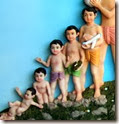 “For
one who has taken his birth, death is certain; and for one who is dead,
birth is certain. Therefore, in the unavoidable discharge of your duty,
you should not lament.” (Lord Krishna, Bhagavad-gita, 2.27)
“For
one who has taken his birth, death is certain; and for one who is dead,
birth is certain. Therefore, in the unavoidable discharge of your duty,
you should not lament.” (Lord Krishna, Bhagavad-gita, 2.27)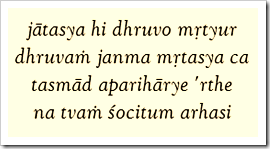 “Let’s
study the iPhone. It’s a revolutionary piece of technology. Before it
was released, I never saw many people carrying the same technological
device. Maybe many people had the iPod, which was the music player made
by the same company, but phones were always varied. Then suddenly so
many people had the exact same model of phone. This wasn’t the cheapest
option by any means. It didn’t have the best service provider, either.
And yet people in droves rushed to the stores to purchase them. When a
new model comes out, there is a long line just to get into the store.
Therefore let us study this phenomenon. Perhaps we can extend our
research to the iPad, which had the single greatest launch in terms of
sales for any technological device.”
“Let’s
study the iPhone. It’s a revolutionary piece of technology. Before it
was released, I never saw many people carrying the same technological
device. Maybe many people had the iPod, which was the music player made
by the same company, but phones were always varied. Then suddenly so
many people had the exact same model of phone. This wasn’t the cheapest
option by any means. It didn’t have the best service provider, either.
And yet people in droves rushed to the stores to purchase them. When a
new model comes out, there is a long line just to get into the store.
Therefore let us study this phenomenon. Perhaps we can extend our
research to the iPad, which had the single greatest launch in terms of
sales for any technological device.” “Let’s
study vitamins. Everyone is taking them these days. Do they actually
work? Which vitamin supplements are necessary and which aren’t? Is it
better to take the supplements or just eat the foods containing those
vitamins? Are there any significant health benefits to taking these
vitamins? Will people actually avoid cancer and other diseases? We’ll
get an experiment set up and monitor the results. Then we’ll report our
findings.”
“Let’s
study vitamins. Everyone is taking them these days. Do they actually
work? Which vitamin supplements are necessary and which aren’t? Is it
better to take the supplements or just eat the foods containing those
vitamins? Are there any significant health benefits to taking these
vitamins? Will people actually avoid cancer and other diseases? We’ll
get an experiment set up and monitor the results. Then we’ll report our
findings.” Of
course the main reason that death does not get studied is that one
cannot see what is going on. You can see the effects of a new
technological gadget. You can observe what happens when people eat a
certain food. You can see how different animals behave. You can’t see,
however, what changes when a person suddenly goes from living to dying.
There are some studies into the physical differences, as in the weight
of the dying person, but there is no way to see exactly what causes the
change. Moreover, why can’t the same person who was alive a minute ago
come back to life?
Of
course the main reason that death does not get studied is that one
cannot see what is going on. You can see the effects of a new
technological gadget. You can observe what happens when people eat a
certain food. You can see how different animals behave. You can’t see,
however, what changes when a person suddenly goes from living to dying.
There are some studies into the physical differences, as in the weight
of the dying person, but there is no way to see exactly what causes the
change. Moreover, why can’t the same person who was alive a minute ago
come back to life?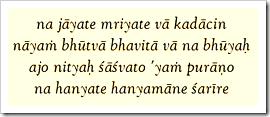 “For
the soul there is never birth nor death. Nor, having once been, does he
ever cease to be. He is unborn, eternal, ever-existing, undying and
primeval. He is not slain when the body is slain.” (Lord Krishna,
Bhagavad-gita, 2.20)
“For
the soul there is never birth nor death. Nor, having once been, does he
ever cease to be. He is unborn, eternal, ever-existing, undying and
primeval. He is not slain when the body is slain.” (Lord Krishna,
Bhagavad-gita, 2.20)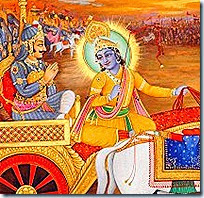 These
truths are straightforward enough. They make sense if we think about it
too. To those who say that we only get one life to live, then we also
only get one childhood. In adulthood that childhood is gone. Was the
childhood wasted, then, if it was spent in study? Did the child waste
their time going to school? On the other side, if a child didn’t go to
school but rather played all day, did they live a successful childhood
life?
These
truths are straightforward enough. They make sense if we think about it
too. To those who say that we only get one life to live, then we also
only get one childhood. In adulthood that childhood is gone. Was the
childhood wasted, then, if it was spent in study? Did the child waste
their time going to school? On the other side, if a child didn’t go to
school but rather played all day, did they live a successful childhood
life?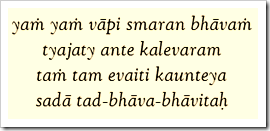 “Whatever state of being one remembers when he quits his body, that state he will attain without fail.” (Lord Krishna, Bg. 8.6)
“Whatever state of being one remembers when he quits his body, that state he will attain without fail.” (Lord Krishna, Bg. 8.6)
















